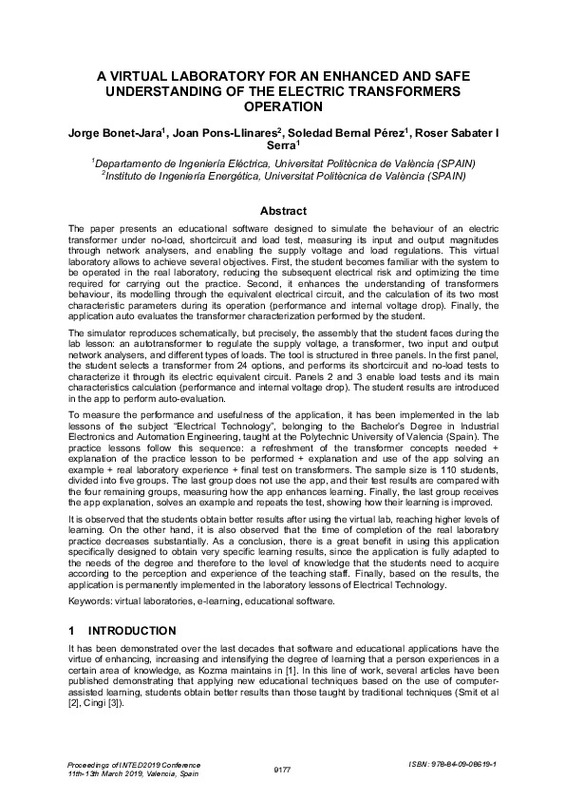|
Resumen:
|
[EN] The paper presents an educational software designed to simulate the behaviour of an electric transformer under no-load, shortcircuit and load test, measuring its input and output magnitudes through network analysers, ...[+]
[EN] The paper presents an educational software designed to simulate the behaviour of an electric transformer under no-load, shortcircuit and load test, measuring its input and output magnitudes through network analysers, and enabling the supply voltage and load regulations. This virtual laboratory allows to achieve several objectives. First, the student becomes familiar with the system to be operated in the real laboratory, reducing the subsequent electrical risk and optimizing the time required for carrying out the practice. Second, it enhances the understanding of transformers behaviour, its modelling through the equivalent electrical circuit, and the calculation of its two most characteristic parameters during its operation (performance and internal voltage drop). Finally, the application auto evaluates the transformer characterization performed by the student.
The simulator reproduces schematically, but precisely, the assembly that the student faces during the lab lesson: an autotransformer to regulate the supply voltage, a transformer, two input and output network analysers, and different types of loads. The tool is structured in three panels. In the first panel, the student selects a transformer from 24 options, and performs its shortcircuit and no-load tests to characterize it through its electric equivalent circuit. Panels 2 and 3 enable load tests and its main characteristics calculation (performance and internal voltage drop). The student results are introduced in the app to perform auto-evaluation.
To measure the performance and usefulness of the application, it has been implemented in the lab lessons of the subject ¿Electrical Technology¿, belonging to the Bachelor¿s Degree in Industrial Electronics and Automation Engineering, taught at the Polytechnic University of Valencia (Spain). The sample size is 96 students and the methodology used is as follows. The 96 students are subdivided into four groups. The practice lessons follow this sequence: a refreshment of the transformer concepts needed + explanation of the practice lesson to be performed + explanation and use of the app solving an example (only for groups 1 and 2) + real laboratory experience + final test on transformers. Finally, the performances between groups 1-2 and 3-4 are compared.
It is observed that the students of groups 1 and 2 obtain better results in the final tests than those of groups 3 and 4, reaching higher levels of learning thanks to the previous use of the simulator. On the other hand, it is also observed that the time of completion of the real laboratory practice decreases substantially in groups 1 and 2. As a conclusion, there is a great benefit in using this application specifically designed to obtain very specific learning results, since the application is fully adapted to the needs of the degree and therefore to the level of knowledge that the students need to acquire according to the perception and experience of the teaching staff. Finally, based on the results, the application is permanently implemented in the laboratory lessons of Electrical Technology.
[-]
|









